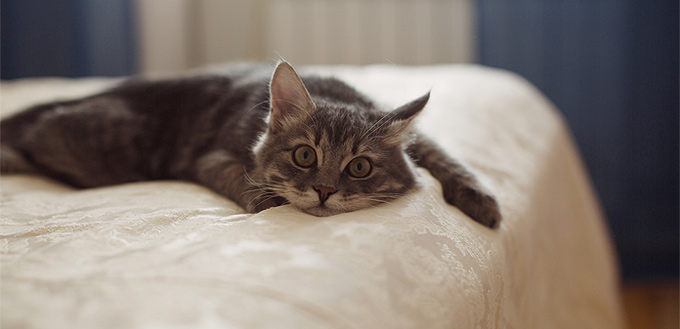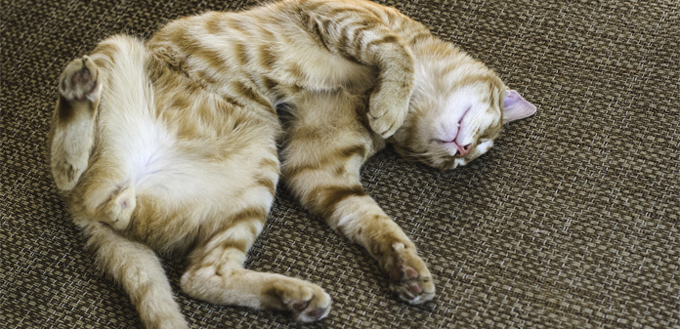We all know that animals, in general, are unable to tell us directly if they’re in pain, and what part of their body hurts. Cats seem to be particularly hard to read, for some reason. But as a responsible pet owner, it’s essential that you know how to recognize the signs, so you can get treatment as soon as possible.
This article explains why pain in cats is so difficult to identify. It also aims to help you detect whether your feline friend is suffering in some way, and lists some of the symptoms that should prompt you to visit your vet.

Why Do Cats Hide Their Pain?
You might expect your cat to yowl and cry if she’s in pain. After all, it stands to reason that any creature that’s hurting should want to vocalize that, either in order to get help or just to show the emotion. But that’s not always the case with felines.
That’s due to their history and nature. Cats aren’t pack animals like dogs are. In the wild, they live alone, except for that brief period when they are mating and, for females, bringing up their kittens. And while they are predators, as relatively small animals, they are also prey for other, larger beasts. Before domestication then, it was important for them to be able to hide signs of weakness or vulnerability. A cat that was weakened by illness or injury would automatically become fair game for any larger predators about, and would not have other cats willing to come and help them. So our felines have learned the hard way that crying out in pain or distress is only likely to bring trouble, not loving care.
That’s why an injured or sick cat will tend to look for a quiet corner in your home, rather than letting you know that she’s in any kind of trouble. And that’s why many pet owners can end up confused and distressed at a vet’s visit because their cat might be diagnosed with a serious illness that they hadn’t previously spotted the signs of. Don’t beat yourself up if this happens to you. As we’ve seen, cats hide their pain well for good reasons.
So What Are the Early Signs That Your Cat Is Suffering?
The first thing to note is that a cat can’t hide everything. Obvious signs that owners need to take some action are actually witnessing your cat having an accident, or if you see her bleeding or limping.
The next tip is to know your pet! If you’re the owner of a cat and have lived with them for a while, then you should have a good understanding of what their normal behavior is like. So your first clue that something is wrong is often that they’re acting differently to how you’d expect. It’s not a 100% certainty that this is an indication of pain, as there could be other causes. Say your cat is off his food, for instance. If you’ve recently changed what you’re feeding him, it could just be that he is wary of the new stuff. Alternatively, though, if he stops crunching biscuits when previously he’s loved them, then it’s possible he’s experiencing dental pain.

Perhaps he has always been religious about using his litter pan and never usually misses, then suddenly begins overshooting and messing on the floor. Try watching his behavior for a little while: observation might tell you that he’s suffering from joint pain or has diarrhea.
Related Post: Best Cat Litter Box
A cat that’s usually friendly and rushes to greet you when you arrive home, but suddenly starts hiding away and acting withdrawn, should ring alarm bells in your head.
All or none of these could be pain-related changes to behavior. But is there any sure-fire way to know that it’s time for a trip to the vet?
What Other Signs to Look For
Even highly experienced vets have long been puzzled about identifying when cats are in physical distress. In 2016, though, a panel of 19 experts in feline medicine got together to publish a paper that outlined their findings and agreement on 25 signs of pain in cats. All 25 indicators don’t need to be present to decide that a cat is in pain, nor is one sign by itself always enough to determine that the cat is hurting. But combinations of a few of these behaviors make it more likely that this is a cat that needs assistance.
- Difficulty jumping
- Lameness
- Reluctance to move
- Abnormal gait
- Reaction to light pressure applied with the hands (palpation)
- Absence of grooming
- Withdrawn or hiding
- Appetite decrease
- Playing less
- Overall activity decrease
- Less affection shown towards people (rubbing around the legs etc)
- General mood
- Temperament
- Posture hunched-up
- Weight shifting
- Persistently licking a particular region of the body
- Lower head posture
- Squinting (blepharospasm)
- Closed eyes
- Changed feeding behaviors
- Avoidance of bright areas
- Groaning
- Growling
- Straining when attempting to urinate
- Tail flicking
It’s still an inexact science. Even given their lengthy discussions, these vets were unable to agree that the presence or absence of any one of these behaviors either guaranteed or discounted the cat being in pain. And there’s no reliable scale yet to determine the degree of pain the cat is in if they show any of these signs, although a broad agreement was reached that panting, pupil dilation and squinting (blepharospasm) were indicators of acute pain. But it’s a useful checklist to work through if you sense something is wrong, but can’t quite put your finger on it.

What Action Should You Take If You Think Your Cat Is in Pain?
Given that cats hide pain well, the importance of annual check-ups, or more frequent ones if you know your cat has an existing health condition, can’t be overstated. After all, you know your cat and your vet knows plenty about feline medicine. Always come to a vet’s appointment prepared with a history of any unusual symptoms and details of any external changes to their normal routine. Outlining these to your vet, combined with their experience, enables you to work as a team to establish whether your cat is suffering in silence.
And between routine check-ups, if your cat is displaying any combinations of the behaviors listed above, or you just feel like something’s not quite right with your beloved pet, then never be afraid to approach your vet to discuss the situation. He or she will always be happy to assist.
Sources:
- Dr. Phil Zeltzman, DVM, DACVS, CVJ, How do You Know if Your Cat is in Pain?, Pet Health Network
- Tom Ryan, Signs of a Kitten’s Pain, The Nest
- Malcolm Weir, DVM, MSc, MPH, How Do I Know if My Cat is in Pain?, VCA Hospitals







